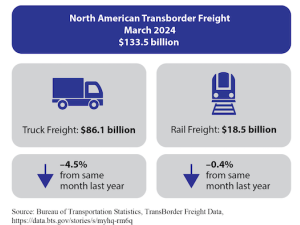Truckload volumes on the spot market were lower overall but showed relative strength during the latter half of November, said DAT Freight & Analytics, which operates the DAT One truckload freight marketplace and the DAT iQ data analytics service.
The DAT Truckload Volume Index (TVI) for van freight was 218, down 9.5% compared to October and 4.4% lower year over year. The refrigerated (“reefer”) TVI was 170, 4.5% lower than in October and down 5.0% year over year.
At 218, the flatbed TVI also fell 11% compared to October but was 13% higher year over year.
“There was seasonality in the van and reefer markets around the Thanksgiving holiday, but also a surge in volume in major intermodal ramp markets like Los Angeles, Chicago, and Kansas City,” said Ken Adamo, DAT Chief of Analytics. “Shippers used the spot market to reduce the risk of disruptions ahead of a potential rail strike.”

Spot rates continued to slide
Spot rates were lower for all three equipment types.
The spot van rate fell 5 cents to $2.38 per mile, a 55-cent decline year over year, while the average reefer rate was $2.80 per mile, down 1 cent month over month and 65 cents lower year over year. The average flatbed rate was $2.82 per mile, 6 cents lower than the October average and down 24 cents year over year.
Spot rates are “all-in” rates and do not include a separate fuel surcharge. Line-haul rates (subtracting an amount equal to an average fuel surcharge) sunk to their lowest point in nearly 2.5 years.
The van line-haul rate dropped 6 cents to $1.71 a mile, and the reefer rate fell 2 cents to $2.07 a mile, the lowest since June 2020 when fuel surcharges averaged 19 cents for van freight and 21 cents for reefer freight.
The line-haul flatbed rate averaged $2.02 a mile, down 7 cents month over month and 54 cents year over year.
Line-haul van and reefer rates have fallen each month since January, when they were $2.70 and $3.15 a mile, respectively.
Load-to-truck ratios were down
Load-to-truck ratios, an indicator of demand on the spot market, declined for all three equipment types.
The national average van load-to-truck ratio was 2.7, meaning there were 2.7 loads for every van posted to the DAT One network. The van ratio was the lowest monthly figure since May 2020 and 1.5 less than in November 2021. The reefer ratio averaged 4.9, down from 5.1 in October, and the flatbed ratio was 9.3, down from 12.5 in October. The flatbed ratio fell for the eighth straight month.
Spread between contract and spot rates increased
The national average shipper-to-broker contract van rate fell 2 cents in November to $3.07 a mile, 12 cents higher than the contract rate in November 2021. The average contract reefer rate was $3.37 a mile, down 1 cent and 27 cents higher year over year, and the average flatbed rate increased by 3 cents to $3.65 a mile, 31 cents higher year over year.
The spread between spot and contract rates for van and reefer freight increased during November. Average spot and contract van rates were virtually equal in February. While spot rates have fallen throughout 2022, contract pricing has been softening since the middle of the year.
“November contract replacement rates—the difference in the rate when one contract ends and another begins—were 12% and 16% lower for vans and reefers, respectively, compared to October,” Adamo said. “We expect spot and contract pricing to continue a downward trajectory but for the gap to narrow during the first quarter of 2023.”











